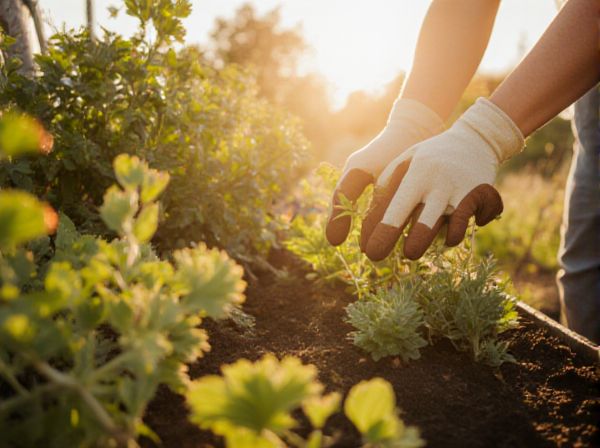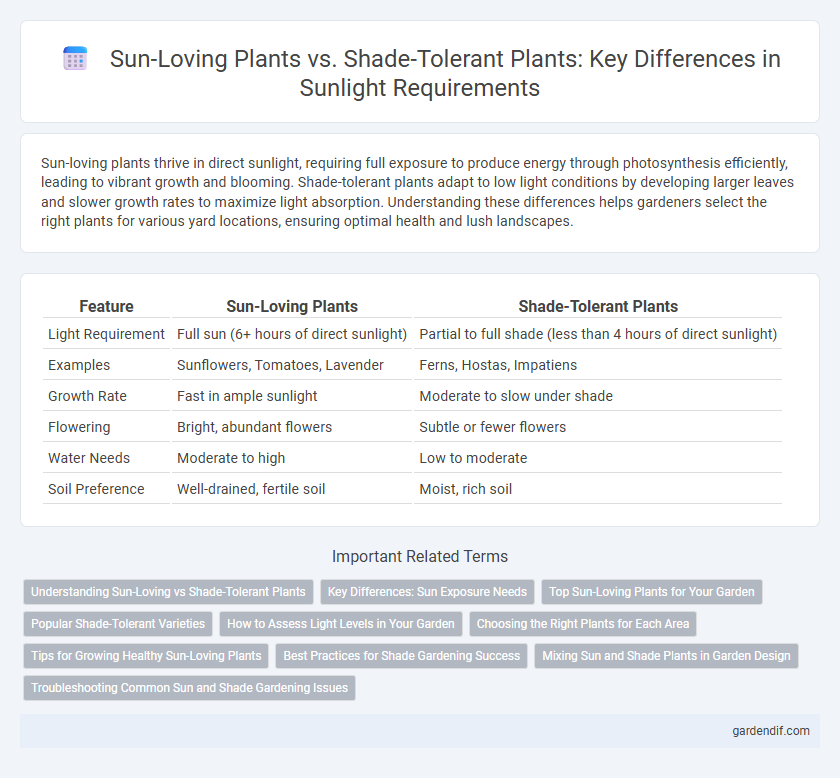
Sun-loving plants vs shade-tolerant plants Illustration
Sun-loving plants thrive in direct sunlight, requiring full exposure to produce energy through photosynthesis efficiently, leading to vibrant growth and blooming. Shade-tolerant plants adapt to low light conditions by developing larger leaves and slower growth rates to maximize light absorption. Understanding these differences helps gardeners select the right plants for various yard locations, ensuring optimal health and lush landscapes.
Table of Comparison
| Feature | Sun-Loving Plants | Shade-Tolerant Plants |
|---|---|---|
| Light Requirement | Full sun (6+ hours of direct sunlight) | Partial to full shade (less than 4 hours of direct sunlight) |
| Examples | Sunflowers, Tomatoes, Lavender | Ferns, Hostas, Impatiens |
| Growth Rate | Fast in ample sunlight | Moderate to slow under shade |
| Flowering | Bright, abundant flowers | Subtle or fewer flowers |
| Water Needs | Moderate to high | Low to moderate |
| Soil Preference | Well-drained, fertile soil | Moist, rich soil |
Understanding Sun-Loving vs Shade-Tolerant Plants
Sun-loving plants thrive in direct sunlight, requiring at least six hours of full sun daily to perform photosynthesis efficiently and produce vibrant blooms or foliage. Shade-tolerant plants adapt to low-light conditions, utilizing filtered or indirect light to survive while minimizing water loss and avoiding leaf scorch. Understanding the specific light requirements of sun-loving versus shade-tolerant plants is crucial for optimal garden placement, ensuring healthy growth and maximizing plant vitality.
Key Differences: Sun Exposure Needs
Sun-loving plants require at least six hours of direct sunlight daily to thrive, optimizing photosynthesis and growth. Shade-tolerant plants adapt to low-light environments with filtered or indirect sunlight, allowing survival under tree canopies or shaded garden areas. Understanding these distinct sunlight exposure needs is crucial for selecting the appropriate species to ensure healthy plant development and garden success.
Top Sun-Loving Plants for Your Garden
Top sun-loving plants for your garden include lavender, zinnia, and marigold, all thriving in full sunlight with at least six to eight hours of direct exposure daily. These plants benefit from intense sunlight, which enhances their vibrant colors, promotes robust flowering, and supports healthy growth patterns. In contrast to shade-tolerant plants, sun-loving varieties require well-draining soil and consistent watering to maximize their sun absorption and overall garden performance.
Popular Shade-Tolerant Varieties
Popular shade-tolerant plants include hostas, ferns, and astilbes, thriving in low-light environments with minimal direct sunlight. These plants adapt to shaded garden areas by maximizing photosynthesis efficiency and often require less water and maintenance compared to sun-loving species such as roses or sunflowers. Shade-tolerant varieties are essential for creating lush, green landscapes in areas where sunlight is limited due to trees or architectural structures.
How to Assess Light Levels in Your Garden
Assessing light levels in your garden involves measuring the intensity and duration of sunlight exposure throughout the day, which is crucial for selecting between sun-loving plants like tomatoes and shade-tolerant species such as ferns. Use tools like a light meter or observe sun patterns to identify full sun areas receiving at least six hours of direct sunlight and shaded spots with filtered or indirect light. Understanding these light conditions ensures optimal plant growth, improving photosynthesis efficiency and overall garden health.
Choosing the Right Plants for Each Area
Sun-loving plants such as tomatoes, roses, and lavender require at least six hours of direct sunlight daily to thrive, making them ideal for open, sunny garden beds. Shade-tolerant plants like ferns, hostas, and impatiens adapt well to areas with limited sunlight, often flourishing with only two to four hours of indirect or dappled light. Selecting plants based on their sunlight preferences ensures optimal growth, health, and vibrant blooms in each designated area of your garden.
Tips for Growing Healthy Sun-Loving Plants
Sun-loving plants such as tomatoes, lavender, and sunflowers require at least six to eight hours of direct sunlight daily to thrive and develop vibrant blooms. Ensuring well-drained soil enriched with organic matter promotes robust root growth, while consistent watering during peak sunlight hours prevents stress and wilting. Regular pruning and mulching help retain moisture and improve air circulation, reducing disease risks in sun-exposed environments.
Best Practices for Shade Gardening Success
Shade-tolerant plants like ferns, hostas, and astilbes thrive in low-light conditions, making them ideal for shaded garden areas where sunlight is limited. Best practices for shade gardening include selecting plants suited to the specific intensity of shade, ensuring soil is well-drained and rich in organic matter, and incorporating mulch to retain moisture. Regular monitoring of light levels and periodic pruning of overhanging branches help optimize growth and maintain healthy shade gardens.
Mixing Sun and Shade Plants in Garden Design
Sun-loving plants such as lavender, rosemary, and marigolds thrive in full sunlight, needing at least six hours of direct sun daily to flourish. Shade-tolerant plants like hostas, ferns, and impatiens adapt well to low-light conditions, making them ideal for shaded garden areas. Combining sun-loving and shade-tolerant plants in garden design creates visually appealing contrasts and ensures diverse plant health by matching species to their optimal light environments.
Troubleshooting Common Sun and Shade Gardening Issues
Sun-loving plants often suffer from leaf scorch, wilting, and stunted growth when exposed to intense, prolonged sunlight, necessitating regular watering and mulching for moisture retention. Shade-tolerant plants may exhibit leggy growth and poor flowering due to insufficient light, requiring strategic pruning and occasional supplemental light or relocation to brighter spots. Proper soil preparation, plant selection based on light requirements, and monitoring for pests or diseases can effectively troubleshoot common sun and shade gardening challenges.
Sun-loving plants vs shade-tolerant plants Infographic

 gardendif.com
gardendif.com